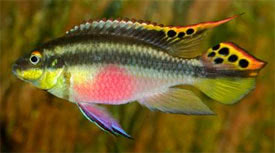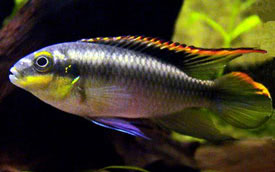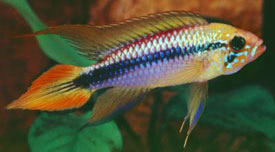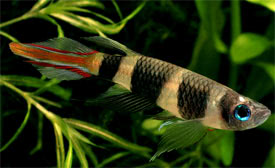
 Magyarul / Hungarian
Magyarul / Hungarian



- Scientific name: Pelvicachromis pulcher
- Synonyms: Pelvicachromis sacrimontis,Pelmatochromis subocellatus kribensis, Pelmatochromis pulcher kribensis, Pelmatochromis pulcher, Pelmatochromis kribensis, Pelmatochromis camerunensis, Pelmatochromis aurocephalus
- Common name: Kribensis, Purple cichlid, Common krib, Rainbow krib
- Group: Cichlids
- Habitat: Africa; Nigeria.
- Size: 8-10 cm.
- Biotope: Found in shallow areas of slow-moving, vegetation choked rivers in the Niger River Delta and other small rivers in South Nigeria. The Krib is found in both brackish and freshwater rivers.
- Social behavior: A peaceful fish that is recommended for a community tank. Pairs form tight monogamous bonds and later patriarch/matriarch families. During the spawning the pair will become territorial, but not aggressive.
- Diet: Live, crustaceans, insect larvae, aquatic insects, Tubifex, flying insects, flakes, pellets.
- Breeding: Easy
- Tank: Minimum 80 litres
- Population: 1 couple for 80 litres
- Decoration: The tank should be heavily planted and have hiding places of wood, rocks, roots, and caves. Use a cover of floating plants to diffuse the lighting and use a dark colored substrate of sand and fine gravel. Leave open swimming areas.
- Temperature: 25-26°C
- pH: 4.8-7.5
- Hardness: 0-12 NK°
- Lifespan: 5-8 years
Description: An elongated cichlid with a long dorsal fin. The male has elongated tips on the dorsal, caudal, and anal fins. The females are stockier with less elongated fins. The body is marked with two lateral, brown stripes; the first passing from the snout, through the eye, and to the tip of the caudal fins, and the other passing from the forehead to the end of the base of the dorsal fin. The main body color is beige to off-white, as is the abdomen. The abdomen becomes a deep magenta to purple color, surrounded by dark blue-gray areas. The pelvic fins are red, purple, and blue while the anal fins is deep blue and magenta. The caudal fin is yellow with the upper edge being orange or red. On males, obvious eye-spots are also located on the upper part of the caudal fin. The dorsal fin is black with a red and yellow edge. The lips often have blue and magenta coloring.
Males are larger with pointed anal, dorsal, and caudal fins. The female is brighter in color and during the spawning season, will develop a deep pink-red to purple belly coloration.
The Krib can be bred in a tank like that mentioned above. Use water with a pH from 6-6.8, a water hardness from 0-6 dH, and a temperature from 79-82°F (26-28°C). Be sure that the tank has well-anchored structures, as this fish will burrow around them in spawning preparation. After an active courtship, in which the female takes a more active role, 50-300 eggs are deposited on the ceiling of a cave or over-turned flowerpot. The eggs are attached by short little threads. The female cares for the eggs-fanning and sucking at them, while the male guards the territory. The eggs hatch in 2-3 days and the fry are free-swimming 4-5 days later. Both parents guard the fry who can be fed on small live and dry foods. The fry like to school. Keep the fry with the parents until the parents are ready to spawn again.






























